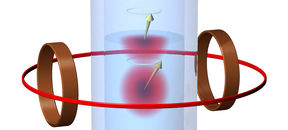Quantum-mechanical interaction between two time crystals has been experimentally demonstrated

Quantum time crystals are systems characterised by spontaneously emerging periodic order in the time domain. In a regular crystal, atoms form periodic order in space, while in a time crystal, a periodic process in time (like oscillation, rotation etc.) spontaneously emerges.
While originally a phase of broken time translation symmetry was a just theoretical exercise, a few practical realisations of time crystals have been reported, such as in previous Aalto research on time crystals.
However, the dynamics and interactions between time crystals have not been investigated experimentally until now
Aalto Senior Scientist, Vladimir Eltsov, explains, 'We have demonstrated the flow of particles between two time crystals as predicted by the famous Josephson effect in quantum mechanics, while coherent time evolution, which is an essence of a time crystal, remains intact'.
Time crystals keep coherence over time, resistant to environmental noise. This is one essential property for building quantum devices (like qubits in a quantum computer). The new finding offers a possibility to precisely manipulate the quantum state.
Eltsov adds, 'In an approach to quantum information processing adopted by the major players (like Google), qubits are based on superconducting quantum electronics: Here islands of a superconductor are interacting by the Josephson effect. In the Josephson effect, coherent electrons flow back and forth between islands in a very specific way, depending on their quantum states'.
For this experiment, a liquid is built from 3He atoms which is cooled to a very low temperature (below 200 microkelvins), where it becomes superfluid. The 3He atoms have a magnetic moment, and at those low temperatures, all of these tiny magnets carried by each atom start to play together. The time crystalline periodic process in this system is the continuous rotation of the total magnetic moment. The constituent particles which are exchanged in the Josephson effect are magnetic quantum excitations, magnons.
Senior Scientist - Vladimir EltsovThis relatively novel phase of matter has earned its place in physicists' vocabulary
Eltsov concludes, 'There is material development effort at some other labs to build similar time crystals based on coherent magnetic phenomena which are robust even at room temperature. Thus in some future, it might enable the construction of a quantum computer operating at room temperature'.
The experiment was performed at the Low Temperature Laboratory of the Department of Applied Physics at Aalto University in collaboration with physicists from Lancaster University (UK), University of London (UK), Yale University (USA) and the Landau Institute for Theoretical Physics (Russia). The research has just been published in Nature Materials.
Support was given by the European Union's Horizon 2020 research and innovation programme.
More information:
Senior Scientist Vladimir Eltsov – Aalto University
ph: : +358-50-3442428
[email protected]
Read more news

DeployAI Partners Gather for Heart Beat Meeting in Helsinki
The European DeployAI project's partners gathered for the Heart Beat meeting hosted by Aalto University Executive Education in Helsinki.
Get to know us: Associate Professor Maria Sammalkorpi
Sammalkorpi received her doctorate from Helsinki University of Technology 2004. After her defence, she has worked as a researcher at the Universities of Princeton, Yale and Aalto.
Aalto computer scientists in ICML 2024
Computer scientists in ICML 2024